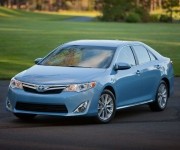The 2012 Toyota Camry Hybrid — can it do magic?Photo: ToyotaThe last three years have been a nightmare for Toyota.
A series of massive recalls involving 10 million vehicles, and the attendant bad press, undermined the Japanese automaker’s defining trait: a reputation for reliability. Stiff competition from other automakers has eroded Toyota’s American market share (from 14.3 percent in 2009 down to 12.8 percent in 2010). Then came the devastating March earthquake and tsunami that interrupted supply chains and slowed or halted much of Japan’s manufacturing. Toyota production plummeted by 23 percent in the first half of 2011.
Hemorrhaging from these and other wounds, Toyota is almost certain to lose its status as the world’s largest automaker to GM (which had held the title for decades until Toyota seized it in 2008).
Hollywood or bust
Toyota is pinning its hopes for the future largely on the 2012 Camry. The company will also be rolling out 20 other updated models over the next year and a half, but it’s no accident that the new Camry is the first out of the gate. For millions of Americans, the midsize sedan is Toyota. The decidedly practical Camry has been the best-selling car in the United States for an amazing 13 out of the last 14 years.
Where do you go if you’re an automaker trying to awaken from a nightmare? To the great American dream factory, of course: Hollywood. In this case, Paramount’s New York City backlot, seen in countless movies and TV shows (such as this car chase scene from the Bruce Willis movie Surrogates; note that the mayhem involves a Chevy and a Cadillac Escalade EXT — no Toyotas were harmed in the making of this film).
Rolling at the rollout.Photo: Osha Gray DavidsonIn late August, Toyota put on the mother of all rollouts here — part NYC street theater (via Hollywood), part music video, and all Madison Avenue. On cue, 200 dancers, actors, skateboarders, and BMX riders came skipping and spinning down the street, decked out in Toyota red, while a live band rocked out high on a balcony above a giant LED screen, and red banners unfurled from wires and shot up from hidden nooks in the street.
I was surprised by the scale of the production — and I wasn’t the only one. Actor Chevy Chase wandered out of soundstage 32 (where the show Community is filmed) and asked a guard in disbelief, “This isn’t for a film? It’s for an e-vent?” drawing out the last syllable to emphasize the improbability of what he was witnessing.
Finally, thousands of red streamers exploded in the air like paper fireworks as a powder-blue 2012 Camry Hybrid and its all-gas equivalent pulled up at the corner of Brooklyn, Greenwich Village, Upper East Side, and SoHo.
Is the Camry the new Prius?
As green car fans know, the Toyota Prius has been the hybrid of choice in the U.S. since it first rolled onto American shores in June 2000. Over a million Prii have been sold since then. That first model got 42 miles per gallon in the city and 41 on the highway, according to the EPA. And the 2011 Prius does significantly better — 51/48, even after the EPA made its mileage standards more rigorous starting with 2008 models.
Although several automakers now sell hybrids, the experts at Edmonds.com still recommend that prospective hybrid buyers “start their search” with the popular Prius, and that’s sound advice.
But if you’re looking for a roomier, more powerful family sedan that just happens to be a hybrid — and gets better gas mileage than the original Prius — the 2012 Camry Hybrid should move to the top of your list. It’s rated at 43/39 mpg — up more than a third from the 2011 Camry Hybrid.
Bob Carter, VP of sales for Toyota USA.Photo: Osha Gray DavidsonHow did they coax that kind of mileage from a midsize sedan? I asked Bob Carter, VP of sales for Toyota USA and host of the unveiling. He credited the new 150 horsepower 2.5-liter 2AR-FXE engine that uses the Atkinson combustion cycle, plus improvements to hardware and software. The new Camry also has better aerodynamics, and it shed 220 pounds in the redesign process.
“This is the newest generation of our hybrid system,” Carter explained. “I’m confident you’ll get better than 45 mpg in the city.”
Despite all these improvements, the new Camry Hybrid has a base sticker price $1,150 lower than the 2011 model it replaces — $25,900.
When it comes to a fun ride, the Camry Hybrid is no Tesla. But it’s no slouch, either. My test drive covered five winding miles from Paramount Studios to Griffith Observatory, including a 600-foot altitude gain. I found the car surprisingly peppy, handling well even on tight turns.
Camrys are known for being quiet and smooth, but the 2012 hybrid generated even less noise and gave a more fluid ride than the 2011 all-gas model, which is saying a lot. If the dashboard hadn’t had an animated icon showing a spinning electric motor, I wouldn’t have been able to tell when the Camry switched between gas and electricity — the transitions were seamless.
Will the new Camry and Camry Hybrid bring about a reversal of fortune for Toyota? Clearly, that’s the company plan. Toyota anticipates selling 50,000 Camry Hybrids in 2012, up from just 15,000 in 2010, says Carter. The extravagant rollout, long list of improvements, and price cut show that Toyota is serious about retaining (or winning back) the Camry’s “most popular car” status next year and restoring the company’s reputation.
I don’t know about Toyota as a whole, or even the gas-powered Camry. But the 2012 Camry Hybrid? Now, there’s a contender.



